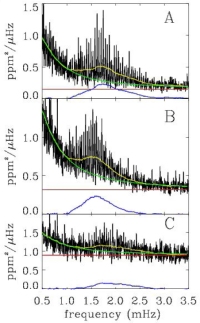CoRoT finds other stars with Sun-like vibrations
24 October 2008
CoRoT has unambiguously detected solar-like oscillations in three main sequence stars. All three stars are of main spectral type F, with a significantly higher effective temperature than our Sun. These results are a milestone for the CNES/ESA CoRoT mission and in general for studies of stellar interiors through asteroseismology.The CoRoT (Convection, Rotation & planetary Transits) spacecraft is equipped with a 27-cm diameter telescope and sophisticated instruments capable of highly accurate photometric observations of stars. Variations in the light from these stars can be measured at the level of 10-6. An international team of astronomers led by Eric Michel from the Observatoire de Paris has used the photometric accuracy of CoRoT to obtain detailed light curves of the three stars HD49933, HD181420 and HD181906 in a search for solar-like oscillations.
Solar-like oscillations
In the upper layer of the Sun's interior – directly beneath the visible surface or photosphere – energy generated in the Sun's core is transported by convection. Here large cells of hot gas rise to the surface where they release their energy and the cooler gas subsequently sinks back down again. This continuous cycle of rising and falling gas generates the characteristic granulation pattern at the Sun's surface.
The same convection process also triggers sound waves that travel through the Sun's interior and cause the entire Sun to vibrate at different frequencies or modes. These vibrations result in periodic variations in the Sun's surface temperature and luminosity. Because the frequencies of these waves and their relative amplitudes depend on the interior make up of the Sun, observing them gives valuable information on stellar structure and energy transport within the star.
Other stars with masses and luminosities differing from our Sun, but with a similar convective upper layer, are expected to also display these characteristic luminosity variations driven by the convection. These solar-like oscillations have now indeed been found with CoRoT in stars of a type that significantly differs from our Sun's which is a G2V star (see table below).
CoRoT results
 |
|
Figure 1. Power density spectra for the stars HD49933, HD181420 and HD181906. |
In an article in today's issue of the Science magazine, Eric Michel and colleagues present results based on light curves that were obtained over a period of 60 days for HD49933 and 156 days for both HD181420 and HD181906.
They found and identified the contribution of solar-like oscillations to the variations in the light curve. These variations are caused by the superposition of all solar-like oscillations that are present in the star.
To reveal the contributions in light variations at the different oscillation frequencies a Fourier power density spectrum is obtained from each lightcurve (Figure 1).
Detailed analysis of the individual frequencies and frequency profiles is ongoing, and in today's article Michel and colleagues present already global characteristics of the oscillations. The measure for the maximum amplitude of the solar-like oscillations is found to be higher than in our Sun by a factor of about 1.5 for all three stars. This is 25% smaller then was anticipated from theory for these types of main sequence stars.
This finding underpins the value of space-based asteroseismological observations for verifying and refining current models of stellar structure and evolution. Space-based observations are not hindered by Earth's atmosphere and can observe a star for long uninterrupted periods of time. Both these factors allow the required level of accuracy for detecting the minute variations in the star's light to be obtained more easily from space than from ground.
General parameters of the three main seqence stars that were the subject of this study:
| Star |
Teff (K) |
L/Lsun |
M/Msun |
Type |
| HD49933 |
6750 ± 60 |
3.47 ± 0.15 |
1.17 ± 0.1 |
F2 |
| HD181420 |
6650 ± 60 |
4.57 ± 0.40 |
1.4 ± 0.1 |
F2 |
| HD181906 |
6380 ± 60 |
3.47 ± 0.45 |
1.2 ± 0.1 |
F8 |
| Star |
Distance |
FK5 coordinates (J2000) | ||
| HD49933 |
~30 pc |
R.A. 06h 50.8m |
Dec. -00° 32' | |
| HD181420 |
~50 pc |
R.A. 19h 20.5m |
Dec. -01° 18' | |
| HD181906 |
~70 pc |
R.A. 19h 22.3m |
Dec. 00° 23' | |
Related publication
Michel, E. et al., "CoRoT Measures Solar-Like Oscillations and Granulation in Stars Hotter Than the Sun", Science, 322, 5901, 558 - 560, DOI: 10.1126/science.1163004

